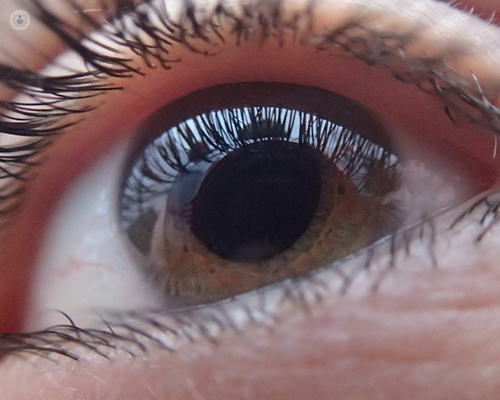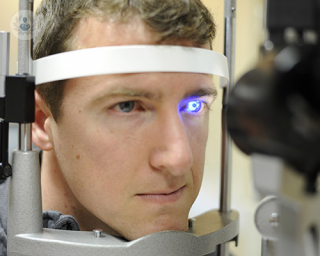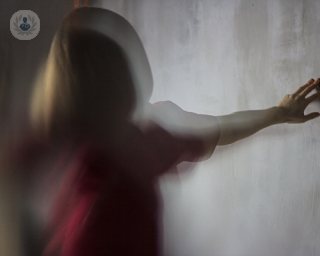Open angle glaucoma
What is open-angle glaucoma?
Open-angle glaucoma is one of the most common types of glaucoma. Glaucoma is a condition that causes damage to the optic nerves of the eyes, and which becomes worse over time. If it continues to worsen, it can lead to permanent vision loss.
Open-angle glaucoma comes on slowly and painlessly, and patients can go for years without noticing that they have it. This is because the initial loss of vision is often to the peripheral vision, whilst general vision is maintained until late into the disease. Open-angle glaucoma tends to occur in people over the age of 50 and generally has no symptoms in the early stages.
Open-angle glaucoma is diagnosed and treated by a consultant ophthalmologist.

What causes open-angle glaucoma?
The eye produces a fluid (aqueous humour), which keeps it healthy and maintains its pressurised state. As new fluid continually comes in, the old has to drain out through the trabecular meshwork, which is a network of cells that sits in an area called the drainage angle. This “open-angle” is where the clear part of the eye (cornea) meets the coloured part (iris) and wraps 360 degrees around the circumference of the front part of the eye.
As we age, the trabecular meshwork does not function so well, which affects the flow of the fluid into and out of the eye, and the level of pressure can rise over time. The elevated eye pressure causes damage to the optic nerve cells, which leads to permanent vision loss.
How is open-angle glaucoma tested for?
The eye specialist will numb the eyes with drops. The doctor checks the eye pressure, looks for an open angle and measures the thickness of the cornea. The patient may also have a dilated eye exam, where the doctor can put a drop on the pupil to make it open wide and to check the optic nerve health.
How is open-angle glaucoma treated?
The damage to the optic nerve and to vision cannot be fixed, but the progression of glaucoma can be slowed down. This is achieved by lowering eye pressure, even if it seems normal. The patient will be provided with eye drops for glaucoma.
If eye drops are not succesful, eye surgery may be required, with the following procedure options which your specialist will recommend depending on the severity of the open-angle glaucoma:
-
Selective laser trabeculoplasty (SLT):
A laser surgery procedure that is used to reduce intraocular pressure by allowing fluid to flow more effectively. The effects are not permanent, and will usually last between 3-5 years. -
Trabeculectomy:
A surgical procedure that creates a new drainage channel for the aqueous humour to leave the eye, lowering intraocular pressure. It is usually recommended when other treatments have not been successful. -
Minimally Invasive Glaucoma Surgery (MIGS):
This is a less-invasive surgical procedure designed to reduce intraocular pressure. -
Glaucoma drainage devices:
Otherwise known as aqueous shunts, are small devices installed in the eye to allow for the drainage of aqueous fluid.
The treatment option decided upon by the ophthalmologist specialist will depend on various factors including the severity of the condition, and the patient's overall health. In some cases, a variety of treatment options may be combined.







